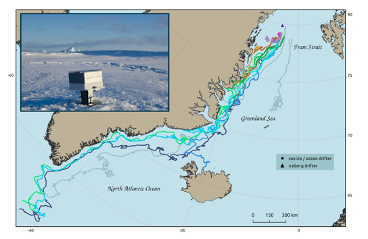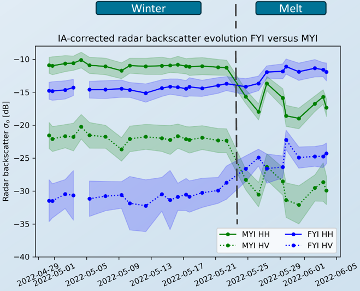Tracking the seasonal evolution of radar backscatter signatures from different sea ice types
Synthetic aperture radar (SAR) is the main tool for operational sea ice monitoring. Due to its all-day and all-weather imaging capability, SAR instruments can reliably provide images throughout the entire year. The radar signal that is backscattered from the sea ice and snow surface is controlled by both surface and radar parameters. The most important radar parameters are frequency, polarization, and incident angle (IA), the dominant surface parameters include small-scale roughness (on the scale of mm to dm), large-scale roughness (deformation on the scale of dm to m), and the electric properties of the ice and snow.
For a given sea ice type, such as for example level first-year ice (FYI) or deformed multi-year ice (MYI), variations in IA and changes in the overlying snowpack during melt onset can cause large variations in the radar backscatter. In the past, these variations have mostly been investigated for stationary landfast ice. In this master project, you will study the effect of IA and seasonal changes on drifting sea ice.
During the CIRFA-22 cruise in April and May 2022, we deployed 17 drift buoys (drifters) on the sea ice close to Greenland. The drifters sampled GPS position every 30 minutes, resulting in the drift trajectories shown in the left figure. These trajectories enable us to identify and track individual sea ice floes in a time series of overlapping Sentinel-1 SAR images and track their backscatter signature over the course of several weeks and months. The figure on the right shows an example result of HH and HV intensity time series from a MYI and an FYI floe, indicating the manually identified timing of melt onset. In this master thesis, you will use the drifter data and overlapping Sentinel-1 imagery to expand the amount of tracked ice floes, and you will identify additional ice types in the imagery and include them in the study. You will then calculate the statistical separability of the different ice types and use this to assess the results of an automated ice type classification algorithm. Finally, you will extract backscatter signature time series over the landfast ice on the Greenland coast and investigate the differences and similarities in the evolution of drift ice and landfast ice backscatter. Depending on your initial findings, progress, and personal interest, there is also the option to work on retraining the classifier to enhance its performance during the melt season.
During this project, you will learn about sea ice types, drift, and classification, and you will gain experience in SAR image processing and interpretation. The work is directly related to several ongoing projects in the Earth Observation group, and you will have a chance to closely work with our PhD students or post-docs.


Left: Trajectories of drifters deployed on the sea ice during the CIRFA-22 cruise in April and May 2022 (map by C. Taelman). Photograph of a drifter after its deployment in the top left corner. Right: Time series of IA-corrected backscatter from example MYI and FYI floes (from Taelman et al., 2023).
Contact: Catherine Taelman (catherine.c.taelman@uit.no)
Literature:
- Taelman, C., Lohse, J., Doulgeris, A.P., Johansson, M. (2023). From winter to melt season: C-band radar backscatter evolution of fast-drifting sea ice floes. Poster presentation at IGS 2023. 10.13140/RG.2.2.11564.44164
- Lohse, J., Doulgeris, A.P., Dierking, W. (2020). Mapping sea-ice types from Sentinel-1 considering the surface-type dependent effect of incidence angle. Annals of Glaciology, 61(83), 260-270. https://doi.org/10.1017/aog.2020.45
- Geldsetzer T., Howell, S. (2023). Incidence angle dependencies for C-band backscatter from sea ice during both the winter and melt season. IEEE Transactions on Geoscience and Remote Sensing. 10.1109/TGRS.2023.3315056
Link to this page





